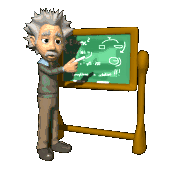Honors Physics - Matter & Energy
Matter
If physics is the study of matter, then we probably ought to define matter. Matter, in scientific terms, is anything that has mass and takes up space. So what's mass? Mass is, in simple terms, the amount of "stuff" an object is made up of. But of course, there's more to the story.
In physics, we differentiate mass into two types... inertial mass and gravitational mass. Inertial mass is an object's resistance to being accelerated by a force. More massive objects accelerate less than smaller objects given an identical force. Gravitational mass, on the other hand, relates to the amount of gravitational force experienced by an object. Objects with larger gravitational mass experience a larger gravitational force.
Confusing? Don't worry! As it turns out, in all practicality, inertial mass and gravitational mass have always been equal for any object measured, even if it's not immediately obvious why this is the case (although with an advanced study of Einstein's Theory of General Relativity you can predict this outcome).
In short, then, matter is anything you can touch – from objects smaller than electrons to stars hundreds of times larger than our sun. From this perspective, physics is the mother of all science. Astronomy to zoology, all other branches of science are subsets of physics, or specializations inside the larger discipline of physics.
Energy
If it's not matter, what's left? Why, energy, of course. As energy is such an everyday term that encompasses so many areas, an accurate definition can be quite elusive. Physics texts oftentimes define energy as the ability or capacity to do work. It's a nice, succinct definition, but leads to another question – what is work? Work can also be defined many ways, but let's start with the process of moving an object. If we put these two definitions together, we can vaguely define energy as the ability or capacity to move an object.
Mass – Energy Equivalence

So far, our definition of physics boils down to the study of matter, energy, and their interactions. Around the turn of the 20th century, however, several physicists began proposing a strong relationship between matter and energy. Albert Einstein, in 1905, formalized this with his famous formula E=mc2, which relates that the mass of an object, a key characteristic of matter, is really a measure of its energy. This discovery has paved the way for tremendous innovation ranging from nuclear power plants to atomic weapons to particle colliders performing research on the origins of the universe. Ultimately, if traced back to its origin, the source of all energy on earth is the conversion of mass to energy!
Scope of Tutorials

Physics, in some sense, can therefore by defined as the study of just about everything. Try to think of something that isn't physics – go on, I dare you! Not so easy, is it? Even the more ambiguous topics can, in some sense, be categorized as physics. A Shakespearean sonnet? A sonnet is typically read from a manuscript (matter), and sensed by the conversion of light (energy) alternately reflected and absorbed from a substrate, focused by a lens in the eye, and converted to chemical and electrical signals by photoreceptors on the retina, and then transferred as electrical and chemical signals along the neural pathways to the brain. That's just the high-level analysis. In short, just about everything is physics from a certain perspective.
As this is an introductory course in physics, we'll limit our scope somewhat as we build up a foundational understanding of the world around us. We'll begin with a study of Newtonian Mechanics, which explores moving objects and their interactions. We'll then talk about the mechanics of fluids, and continue on by talking about thermal energy and its transfer. From there, we'll move into electricity and magnetism. Next, we'll briefly explore how the application of physics and engineering principles to semiconductors hsa changed our world. Then, we'll talk about the transfer of energy using waves. Next, using what we've learned about physical waves, we'll expand into electromagnetic waves and optics. Finally, we'll end the course by looking at matter again, this time at the nuclear level, using our background in mechanics, electricity and magnetism, waves, and optics to build a deeper understanding of the building blocks of our existence.
Join me as we take our first steps into a better understanding of the universe we live in.

